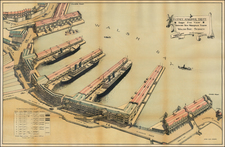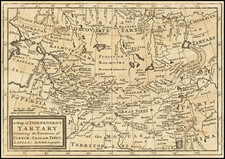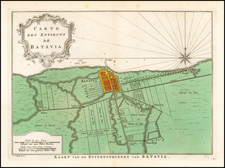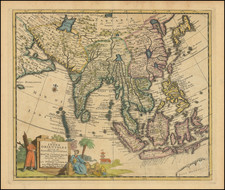Striking old color example of the title page for Blaeu's atlas of China, first published in 1655.
This fine allegorial seen shows the gateway to China being thrown open, with the latin phrase " clausa recludo" ("I open the closed places"), with a group of angels with various navigational devices looking over a map of China and a globe oriented toward Southeast Asia and a partially known Australia.
At the top, the allegorical scene shows the Jesuit symbol IHS (Society of Jesus) shining light on the world, with an allegorical symbol for Christianity reflecting the light in order to light a torch in the hands of a winged angel sitting atop the wall of the gate to the Middle Kingdom, with a procession of angels bearing symbols of Christian faith above.
This powerful image pays tribute to the efforts of the Jesuits to bring Christianity to China and the resultant geographical and other information which they compiled during they missionaries travels and embasssies. Martino's reporting on China revolutionized the mapping of the region and was the first significant leap forward in the geographical knowledge of China in over nearly 50 years, and would shape the depiction of the Middle Kingdom for the rest of the 17th Century.
Willem Janszoon Blaeu (1571-1638) was a prominent Dutch geographer and publisher. Born the son of a herring merchant, Blaeu chose not fish but mathematics and astronomy for his focus. He studied with the famous Danish astronomer Tycho Brahe, with whom he honed his instrument and globe making skills. Blaeu set up shop in Amsterdam, where he sold instruments and globes, published maps, and edited the works of intellectuals like Descartes and Hugo Grotius. In 1635, he released his atlas, Theatrum Orbis Terrarum, sive, Atlas novus.
Willem died in 1638. He had two sons, Cornelis (1610-1648) and Joan (1596-1673). Joan trained as a lawyer, but joined his father’s business rather than practice. After his father’s death, the brothers took over their father’s shop and Joan took on his work as hydrographer to the Dutch East India Company. Later in life, Joan would modify and greatly expand his father’s Atlas novus, eventually releasing his masterpiece, the Atlas maior, between 1662 and 1672.










![Gerardus Mercator . . . [and] . . . Iudocus Hondius . . .](https://storage.googleapis.com/raremaps/img/small/78439.jpg)



